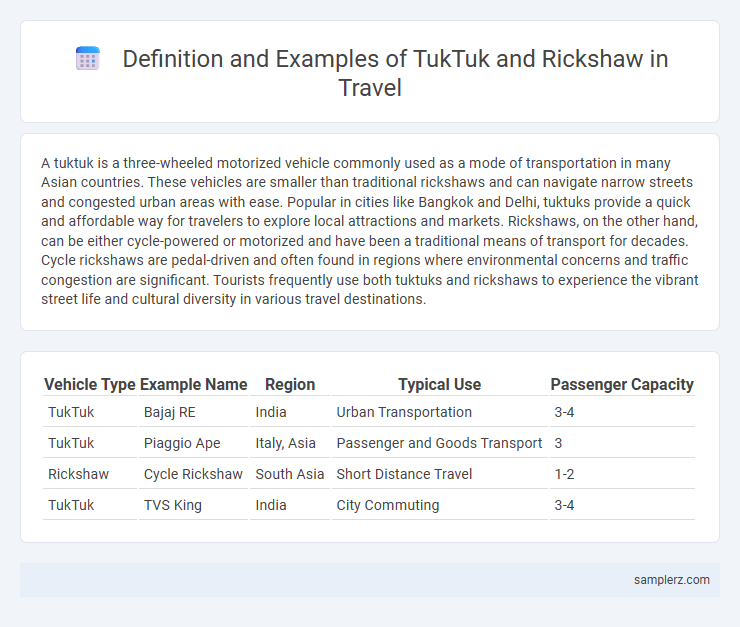A tuktuk is a three-wheeled motorized vehicle commonly used as a mode of transportation in many Asian countries. These vehicles are smaller than traditional rickshaws and can navigate narrow streets and congested urban areas with ease. Popular in cities like Bangkok and Delhi, tuktuks provide a quick and affordable way for travelers to explore local attractions and markets. Rickshaws, on the other hand, can be either cycle-powered or motorized and have been a traditional means of transport for decades. Cycle rickshaws are pedal-driven and often found in regions where environmental concerns and traffic congestion are significant. Tourists frequently use both tuktuks and rickshaws to experience the vibrant street life and cultural diversity in various travel destinations.
Table of Comparison
| Vehicle Type | Example Name | Region | Typical Use | Passenger Capacity |
|---|---|---|---|---|
| TukTuk | Bajaj RE | India | Urban Transportation | 3-4 |
| TukTuk | Piaggio Ape | Italy, Asia | Passenger and Goods Transport | 3 |
| Rickshaw | Cycle Rickshaw | South Asia | Short Distance Travel | 1-2 |
| TukTuk | TVS King | India | City Commuting | 3-4 |
Introduction to Tuktuks and Rickshaws
Tuktuks and rickshaws are iconic modes of transportation commonly found in many Asian countries, offering an affordable and efficient way to navigate crowded urban streets. These three-wheeled vehicles are known for their compact size, maneuverability, and ability to transport passengers and small goods quickly through narrow alleys. Serving both locals and tourists, tuktuks and rickshaws provide an authentic cultural experience while helping reduce traffic congestion in bustling cities.
Historical Evolution of Tuktuks and Rickshaws
The historical evolution of tuktuks and rickshaws traces back to the late 19th century when hand-pulled rickshaws emerged in Japan as a popular mode of urban transportation. By the mid-20th century, motorized tuktuks gained prominence in Southeast Asia, especially Thailand and India, introducing a three-wheeled auto-rickshaw that combined efficiency with affordability. This transformation from hand-pulled to motorized forms reflects significant advancements in urban transit and adaptation to growing city populations.
Key Differences Between Tuktuks and Traditional Rickshaws
Tuktuks feature motorized engines that provide faster and more efficient transportation compared to traditional rickshaws, which rely on manual pedaling or pulling. Unlike manual rickshaws, tuktuks offer greater passenger capacity and enhanced comfort with enclosed cabins, making them suitable for urban commuting. The mechanical design of tuktuks allows for longer travel distances and better adaptability to various terrains, distinguishing them from the simpler, environmentally friendly human-powered rickshaws.
Popular Destinations for Tuktuk Rides
Bangkok, Thailand remains one of the most popular destinations for tuktuk rides, offering vibrant street views and easy access to landmarks like the Grand Palace and Wat Arun. Delhi, India attracts tourists who enjoy tuktuk journeys through bustling markets and historic sites such as Chandni Chowk and Qutub Minar. In Colombo, Sri Lanka, tuktuks provide a convenient way to explore the city's coastal roads and cultural attractions like the Galle Face Green and Gangaramaya Temple.
Iconic Tuktuk Designs Around the World
Iconic tuktuk designs, such as the brightly colored, intricately decorated models found in Bangkok, Thailand, showcase vibrant patterns and cultural motifs that attract tourists worldwide. In India, tuktuks feature bold paint jobs and customized interiors, reflecting local artistry and urban flair. Sri Lankan tuktuks often incorporate floral decals and religious symbols, making each vehicle a moving representation of regional heritage and tradition.
Environmental Impact of Tuktuks vs Rickshaws
Tuktuks, powered mainly by compressed natural gas (CNG) or electricity, produce significantly lower emissions compared to traditional rickshaws that often rely on gasoline engines. The lightweight design and efficient fuel consumption of electric tuktuks minimize air pollution and carbon footprint in densely populated urban areas. Switching from conventional rickshaws to electric or CNG-powered tuktuks contributes to cleaner air quality and reduces noise pollution in cities.
Cost Comparison: Tuktuk vs Rickshaw Rides
Tuktuk rides typically cost between $1 to $3 per kilometer, making them slightly more expensive than traditional rickshaw rides, which average around $0.50 to $1.50 per kilometer. The difference in fare reflects the motorized convenience of tuktuks compared to human-powered rickshaws, especially in busy urban areas like Bangkok or Delhi. For short trips under 5 kilometers, rickshaws offer a budget-friendly option, while tuktuks provide faster travel at a higher price point.
Safety Tips for Riding in Tuktuks
When riding in a tuktuk, always ensure the driver uses a properly maintained vehicle equipped with functioning brakes and lights. Wear seat belts if available, and avoid overloading the tuktuk beyond its recommended capacity to prevent accidents. Stay alert by keeping your belongings secure and avoiding distractions while navigating busy streets.
Unique Tuktuk Experiences for Travelers
Tuk-tuks provide travelers with a uniquely immersive way to explore bustling city streets, offering close-up views of local life and vibrant markets. Their compact size allows access to narrow alleys and hidden gems often missed by larger vehicles. Riding a tuk-tuk combines adventure with cultural immersion, making it a must-experience mode of transportation in destinations like Bangkok, Chennai, and Hanoi.
Future Trends in Tuktuk and Rickshaw Transportation
Autonomous electric tuktuks and rickshaws are set to revolutionize urban transportation by reducing emissions and improving efficiency. Integration of IoT technology enables real-time tracking, route optimization, and enhanced passenger safety. Smart battery advancements extend vehicle range, making eco-friendly tuktuks and rickshaws a viable option for sustainable city travel.

example of tuktuk in rickshaw Infographic
 samplerz.com
samplerz.com